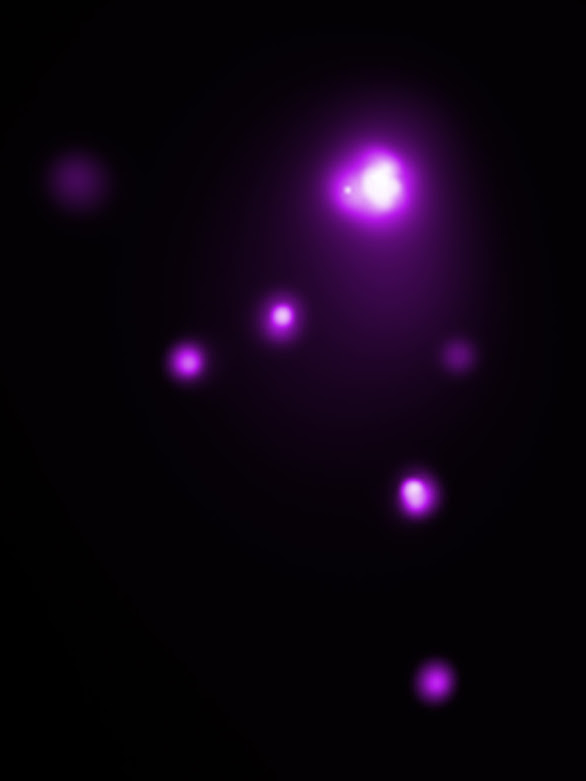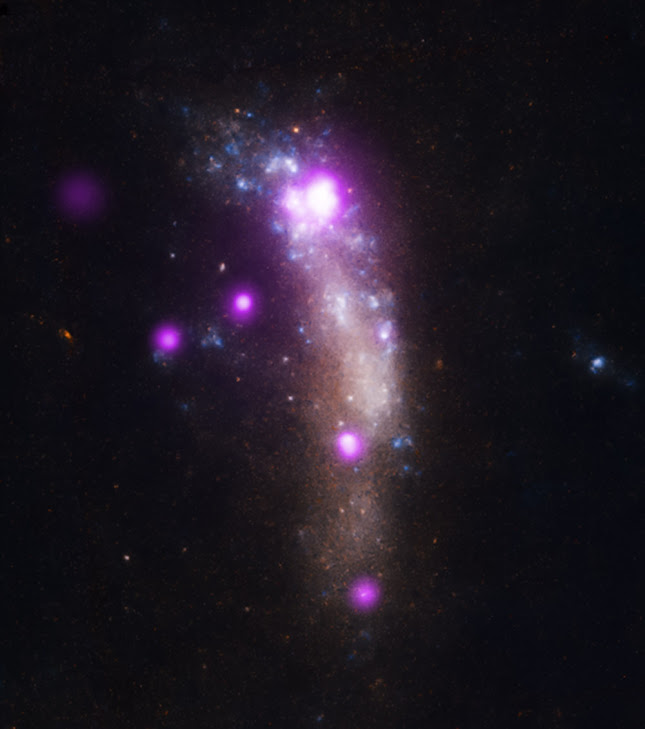Observations with NASA's Chandra X-ray Observatory have provided the first X-ray evidence of a supernova shock wave breaking through a cocoon of gas surrounding the star that exploded. This discovery may help astronomers understand why some supernovas are much more powerful than others.
The composite image of UGC 5189A shows X-ray data from Chandra in purple and optical data from Hubble Space Telescope in red, green and blue. SN 2010jl is the very bright X-ray source near the top of the galaxy.
A team of researchers used Chandra to observe this supernova in December 2010 and again in October 2011. The supernova was one of the most luminous that has ever been detected in X-rays.
In optical light, SN 2010jl was about ten times more luminous than a typical supernova resulting from the collapse of a massive star, adding to the class of very luminous supernovas that have been discovered recently with optical surveys. Different explanations have been proposed to explain these energetic supernovas including (1) the interaction of the supernova's blast wave with a dense shell of matter around the pre-supernova star, (2) radioactivity resulting from a pair-instability supernova (triggered by the conversion of gamma rays into particle and anti-particle pairs), and (3) emission powered by a neutron star with an unusually powerful magnetic field.
In the first Chandra observation of SN 2010jl, the X-rays from the explosion's blast wave were strongly absorbed by a cocoon of dense gas around the supernova. This cocoon was formed by gas blown away from the massive star before it exploded.
In the second observation taken almost a year later, there is much less absorption of X-ray emission, indicating that the blast wave from the explosion has broken out of the surrounding cocoon. The Chandra data show that the gas emitting the X-rays has a very high temperature – greater than 100 million degrees Kelvin – strong evidence that it has been heated by the supernova blast wave.
The energy distribution, or spectrum, of SN 2010jl in optical light reveals features that the researchers think are explained by the following scenario: matter around the supernova has been heated and ionized (electrons stripped from atoms) by X-rays generated when the blast wave plows through this material. While this type of interaction has been proposed before, the new observations directly show, for the first time, that this is happening.
This discovery therefore supports the idea that some of the unusually luminous supernovas are caused by the blast wave from their explosion ramming into the material around it.
In a rare example of a cosmic coincidence, analysis of the X-rays from the supernova shows that there is a second unrelated source at almost the same location as the supernova. These two sources strongly overlap one another as seen on the sky. This second source is likely to be an ultraluminous X-ray source, possibly containing an unusually heavy stellar-mass black hole, or an intermediate mass black hole.
These results were published in a paper appearing in the May 1st, 2012 issue of The Astrophysical Journal Letters. Here below is the abstract from the paper:
We report two epochs of Chandra-ACIS X-ray imaging spectroscopy of the nearby bright Type IIn supernova SN 2010jl, taken around two months and then a year after the explosion. The majority of the X-ray emission in both spectra is characterized by a high temperature (≳10 keV) and is likely to be from the forward shocked region resulting from circumstellar interaction. The absorption column density in the first spectrum is high (~1024 cm–2), more than three orders of magnitude higher than the Galactic absorption column, and we attribute it to absorption by circumstellar matter. In the second epoch observation, the column density has decreased by a factor of three, as expected for shock propagation in the circumstellar medium. The unabsorbed 0.2-10 keV luminosity at both epochs is ~7 × 1041 erg s–1. The 6.4 keV Fe line clearly present in the first spectrum is not detected in the second spectrum. The strength of the fluorescent line is roughly that expected for the column density of circumstellar gas, provided the Fe is not highly ionized. There is also evidence for an absorbed power-law component in both spectra, which we attribute to a background ultraluminous X-ray source.
 |
| Optical image of the galaxy UGC 5189A from the Hubble Space Telescope. Credit: NASA/STScI |
 |
| X-ray image from Chandra Space Telescope of SN 2010jl and other x-ray sources in the same region of the sky. Credit: X-ray: NASA/CXC/Royal Military College of Canada/P.Chandra et al. |
Sources:
- SN 2010jl: A supernova cocoon breakthrough, Chandra X-ray Observatory, May 15, 2012
- Strong Evolution of X-Ray Absorption in the Type IIn Supernova SN 2010jl, Poonam Chandra et al. 2012 ApJ 750 L2
